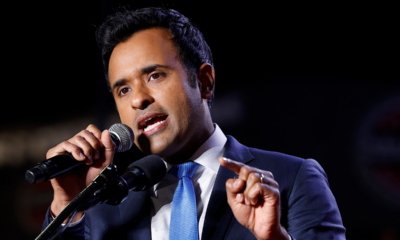Washington, D.C
Biden touts efforts to lower care costs, takes aim at GOP

President Joe Biden on Tuesday made the just under two-mile trip from the White House to join care workers and union members at Washington’s Union Station, where he touted his investments in child care, home care, paid family and medical leave and more.
“We’ve made progress but there is so much more that we have to do, so much more,” Biden said to cheers from those in the crowd, many of whom were sporting purple Service Employees International Union shirts. “If we want the best economy in the world, we have to have the best caregiving economy in the world – we really do.”
The president on Tuesday made the case that his legislative priorities – particularly the American Rescue Plan he signed in 2021, which the White House noted provided $39 billion in child care relief – is helping make care more affordable for Americans.
“Not a single Republican voted for it, I might add. Not one,” Biden said on Tuesday. “It made our nation’s biggest investment in childcare ever.”
Biden, according to the White House, has secured a nearly 50% increase in federal child care assistance since he took office. Last year, he signed an executive order that contains more than 50 directives to increase access to child care and improve the work life of caregivers.
“But the cost of care is too high and pay for care workers is much too low,” Biden said.
The cost of child care has risen 26% in the last 10 years, according to the White House. A survey by Care.com in 2022 found about 63% of parents said the cost of child care had become more expensive over the last year.
During his remarks on Tuesday, Biden also noted that the average family spends $11,000 on childcare per kid each year. He said the cost of long-term care for older Americans and those with disabilities rose 40% in the last decade.
“In the United States of America, no one – no one should choose between caring for a parent who’s raised them, a child who depends on them, [and] a paycheck that they need,” said Biden, who opened his remarks speaking about his own concerns about with childcare for his two sons after his first wife and daughter were killed in a car accident.
The president’s budget for the next fiscal year calls a restoration of the expanded Child Tax Credit and a national paid family and medical leave program, among other things. The White House noted Biden also wants to expand Medicaid home and community-based services in order to enable more seniors and people with disabilities to get care in their own home or community.
Biden’s budget would also establish a new program that would offer working families earning less than $200,000 annually with high-quality child care from birth until kindergarten for no more than $10 a day
The new initiatives in Biden’s 2025 fiscal year budget — on health care, child care, homeownership and more — would be paid for by tax hikes on large corporations and the wealthiest Americans.
Biden on Tuesday said that in the “coming weeks” his administration plans to “release new rules to strengthen staffing standards in nursing homes, to get homecare workers a bigger share of Medicaid payments.”
The president also criticized Republicans on Tuesday, saying a budget proposed by a large group in the House GOP, the Republican Study Committee, would cut existing caregiving programs by a third.
Spectrum News’ Ryan Chatelain contributed to this report.

Washington, D.C
ECU football heads to Washington, D.C., for Military Bowl preparations

East Carolina’s football team is spending Christmas week in the nation’s capital as the Pirates prepare for their upcoming Military Bowl matchup against Pittsburgh.
The team departed Greenville around 11 a.m. Tuesday, loading onto five buses for the road trip to Washington, D.C. Head coach Blake Harrell rode on the lead bus as the Pirates left campus to continue bowl preparations.
While in the area, ECU is mixing business with some downtime. The team has scheduled practices but is also taking in professional hockey and football games during the trip.
The Pirates’ Christmas Eve schedule includes a practice in Springfield, Virginia, followed by community service and a team bowling event in Bethesda, Maryland.
ECU faces Pittsburgh in the Military Bowl on Saturday.
Panthers prepare for final home game
The Carolina Panthers, currently in first place, are preparing for their final home game of the regular season. Carolina will host the Seattle Seahawks, led by former Panthers quarterback Sam Darnold.
Panthers head coach Dave Canales spent 13 years with the Seahawks organization under longtime coach Pete Carroll and the team’s front office.
Carolina cornerback Jaycee Horn was named to the Pro Bowl and is expected to face a challenge against Darnold and Seattle’s offense.
Christmas Day NFL matchups
NFL fans will have three games to watch on Christmas Day, including a matchup featuring former Wallace-Rose Hill standout Javonte Williams and the Dallas Cowboys visiting the Washington Commanders.
UNC routs ECU in college basketball
In college basketball, North Carolina had little trouble defeating East Carolina at the Dean Dome, winning 99-51.
UNC’s Caleb Wilson scored 21 points and added 12 rebounds, while Henri Veesaar chipped in 13 points.
ECU’s Giovanni Emejuru led the Pirates with 21 points, but the team struggled offensively, shooting 1 of 20 from 3-point range and committing 17 turnovers.
Both teams will break for the week before returning to conference play. UNCW is scheduled to be the first regional team back in action.
Washington, D.C
The Trump administration is suing the District of Columbia over its gun laws – WTOP News

The Trump administration is suing the local government of Washington, D.C., over its gun laws, alleging that restrictions on certain semiautomatic weapons run afoul of Second Amendment rights
The Trump administration is suing the local government of Washington, D.C., over its gun laws, alleging that restrictions on certain semiautomatic weapons run afoul of Second Amendment rights.
The U.S. Department of Justice filed its lawsuit Monday in U.S. District Court in the District of Columbia, naming Washington’s Metropolitan Police Department and outgoing Chief of Police Pamela Smith as defendants and setting up another potentially seismic clash on how broadly the courts interpret individual gun possession rights.
“The United States of America brings this lawsuit to protect the rights that have been guaranteed for 234 years and which the Supreme Court has explicitly reaffirmed several times over the last two decades,” the Justice Department states.
It’s the second such lawsuit the administration has filed this month: The Justice Department also is suing the U.S. Virgin Islands, alleging the U.S. territory is obstructing and systematically denying American citizens the right to possess and carry guns.
It’s also the latest clash between the District of Columbia and the federal government, which launched an ongoing law enforcement intervention into the nation’s capital over the summer, which was meant to fight crime. The district’s attorney general is challenging the deployment of the National Guard to the city as part of the intervention in court.
In Washington, Metropolitan Police Department spokesman Sean Hickman said the agency does not comment on pending litigation.
The Justice Department asserts that the District is imposing unconstitutional bans on AR-15s and other semiautomatic weapons the administration says are legal to posses under the Supreme Court’s 2008 Heller precedent, which also originated from a dispute over weapons restrictions in the nation’s capital.
In that seminal case, the court ruled that private citizens have an individual right to own and operate weapons “in common use today,” regardless of whether they are part of what Second Amendment text refers to as a “well regulated militia.”
“There seems to us no doubt, on the basis of both text and history, that the Second Amendment conferred an individual right to keep and bear arms,” the majority reasoned. The justices added a caveat: “Of course, the right was not unlimited, just as the First Amendment’s right of free speech was not.”
The Justice Department argues that the District has gone too far in trying to limit weapons possession under that caveat. Administration lawyers emphasize the Heller reference to weapons “in common use today,” saying it applies to firearms that District of Columbia residents cannot now register. Those restrictions in turn subject residents to criminal penalties for unregistered firearms, the administration asserts.
“Specifically, the District denies law-abiding citizens the ability to register a wide variety of commonly used semi-automatic firearms, such as the Colt AR-15 series rifles, which is among the most popular of firearms in America, and a variety of other semi-automatic rifles and pistols that are in common use,” Justice Department lawyers write.
“D.C’s current semi-automatic firearms prohibition that bans many commonly used pistols, rifles or shotguns is based on little more than cosmetics, appearance, or the ability to attach accessories,” the suit continues, “and fails to take into account whether the prohibited weapon is ‘in common use today’ or that law-abiding citizens may use these weapons for lawful purposes protected by the Second Amendment.”
The Justice Department does not include any individual plaintiffs from Washington, D.C., alleging any violations of their constitutional rights. That’s different from the Heller case, which is named for Dick Heller, a Washingtonian who filed a civil lawsuit challenging the city’s handgun ban in 2003.
The administration argues in the suit that it has jurisdiction to challenge current District laws under the sweeping federal crime law of 1994.
Copyright
© 2025 The Associated Press. All rights reserved. This material may not be published, broadcast, written or redistributed.
Washington, D.C
Virginia Lawmakers Raise Safety Concerns Over Aircraft Safety After Fatal D.C. Crash

WASHINGTON, D.C. (WAVY) — On Dec. 10, U.S. Reps. Don Beyer, Suhas Subramanyam, James Walkinshaw, Bobby Scott, Jennifer McClellan and Eugene Vindman, members of Virginia’s congressional delegation, issued a statement regarding Section 373 of the National Defense Authorization Act for fiscal year 2026.
The section addresses manned rotary-wing aircraft safety in the wake of the Jan. 29, 2025, midair collision at Ronald Reagan Washington National Airport that killed 67 people.
The lawmakers said they share concerns raised by the Families of Flight 5342 and the National Transportation Safety Board over Section 373 of the National Defense Authorization Act, citing safety risks in the airspace around Reagan National Airport following January’s fatal collision.
Congress said the provision allows waivers for training flights that could further congest already crowded airspace.
Congress stated, “This provision falls short of NTSB’s preliminary safety recommendations and omits changes that are essential to improve visibility, safety and communications between military and civilian aircraft in D.C. airspace. Further action is needed to prevent a repetition of the mistakes that led to this incident. We will continue working as quickly as possible with our colleagues and transportation officials to get this right before any waivers are issued and to ensure air safety in the region.”
-

 Iowa1 week ago
Iowa1 week agoAddy Brown motivated to step up in Audi Crooks’ absence vs. UNI
-

 Maine1 week ago
Maine1 week agoElementary-aged student killed in school bus crash in southern Maine
-

 Maryland1 week ago
Maryland1 week agoFrigid temperatures to start the week in Maryland
-

 New Mexico7 days ago
New Mexico7 days agoFamily clarifies why they believe missing New Mexico man is dead
-

 South Dakota1 week ago
South Dakota1 week agoNature: Snow in South Dakota
-

 Detroit, MI1 week ago
Detroit, MI1 week ago‘Love being a pedo’: Metro Detroit doctor, attorney, therapist accused in web of child porn chats
-

 Health1 week ago
Health1 week ago‘Aggressive’ new flu variant sweeps globe as doctors warn of severe symptoms
-

 Maine7 days ago
Maine7 days agoFamily in Maine host food pantry for deer | Hand Off






















